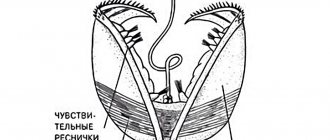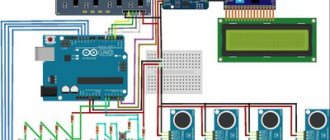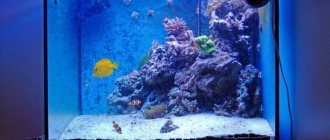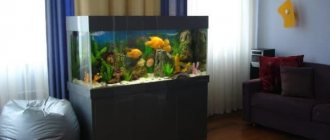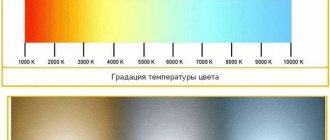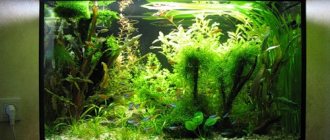Video about the practice of using phytolamps for growing plants:
1) Forums and demagoguery. What surprised me most was the communication on the forums. There, 90-95% of people who have not even tried LEDs are trying to claim something (that they are better or worse), in fact there were several people who tried them. Everything else is empty chatter, theoretical arguments, misconceptions, flood... The conclusion so far is this: if you don’t want to get confused and get misinformation, don’t read the forums. For example, many people think that they can use a lux meter to compare different types of lamps for their effectiveness in illuminating plants. No! A lux meter can only compare the same types of lamps and more for other purposes. It does not give an idea of the spectral properties of the light from the phytolamp! Oh, these forums... There are almost no people there who really understand and who have at least tried something! By the way, I once came across a report with a photo of a family who tried LEDs, the results were average, but the problem is that they were sold cheap low-power LEDs of the wrong class for a significant amount. In short, their sellers deceived them. Such as they had - they had to be placed close to the plants.
Video review about phytolamps and their manufacturers:
2) China or? Professional American or European phytolamps are not yet available to us (and they cost a lot of money, just not real), and those that are available are Chinese, issued under European brands!!! Therefore, feel free to buy Chinese ones, and do not overpay for deceiving sellers and distributors. The Chinese now have more than fifty factories specializing in the topic of phytolight. And many do it very well. You will know how to choose and what to look for after reading this article to the end. All LEDs are mostly made in China anyway! (and the lamps can be assembled even in the Moscow region). But I don’t recommend domestic ones yet - the fact is that the ones I saw were very weak in characteristics, and were presented as “super duper”. Or I also met the cheapest Chinese ones under the guise of “ours,” but with a good markup. In short, a buyer's scam.
3) HPS or LED? I'll say it briefly. They are very close in their positive effect on plants. HPS is good for growth, but dangerous (strong heating, high currents), my friend’s HPS exploded behind his back (well, behind his back) and I pulled out the smallest fragments from his back for about thirty minutes. Personally, what depresses me most about DNAT and similar systems is the complexity of the installation (there are many requirements on how to do it wisely - it will be difficult for beginners to take everything into account), the presence of additional equipment and losses, and the fire hazard. As a result, according to my data, LEDs will be 30–50% more efficient overall (again, if you take the right phytolamps and install them as needed, and not as you might think). LEDs are safer and simpler no matter what (I’m always afraid of getting a pinch when the equipment works for a long time and unattended).
4) Why LEDs at all? Here you can read theories, but it’s difficult to find; I even had to sit with translators and read reports from foreign scientists (I couldn’t find our specialists in this field). I will summarize the main thing that is worth remembering and accepting: A) plants perceive light in the wavelength range from 400 to 700 nm. B) There are two wavelength regions at which growth is most susceptible: 420-470 and 620-670 n.m. C) Red light in the range 620-670 (even more than 660 nm) is almost 1.5 times more effective than the blue range. But it is worth understanding that this is within the framework of universality. Sometimes some plants have different priorities at different stages. D) The intensity of photosynthesis is higher in the red range, because it is proportional to the number of quanta (not energy). The number of quanta per watt in red light is simply greater! As a result, we have the following data. What about LEDs? Yes, the whole point is that LEDs can be created with very specific emission properties and a narrow range, spending precious energy precisely on the spectrum that gives the greatest effect for the plant! This is the main advantage on which LED phytolamps are based. All other advantages of LEDs have long been known.
5) Cheap LEDs. The characteristics of LEDs vary greatly. I won’t go into detail, I’ll tell you the gist. One powerful LED is better than 100 cheap low-power LEDs with questionable characteristics! Remember this. There are, of course, cases when it is convenient to use not very powerful ones, for example, if you are making a growing setup with low-height trays and shelves, then it is better to use less powerful LEDs, but distributed over a larger area. In good LED phytolamps (lamps), the LEDs should have a rated power of 1 to 5 W. And the rule: expensive, good LEDs have higher efficiency for you and your plant (both in terms of energy savings and impact on the plant).
6) Homemade phytolights made from LEDs. Of course, you can buy the parts yourself, pick up a tool and make a lamp. But there are many pitfalls, because of which 99% of those who try will remain dissatisfied with the result... 1. Good LEDs can be bought rarely and from specialized companies, and not at junk shops or online stores of junk for a ruble! 2. LEDs need a control driver. A lot will depend on his work. So there are problems with these drivers in the market. You definitely won't find any cheap ones. My friend makes lamps for cars and in the end was forced to assemble the drivers himself! 3. Design and cooling. Again, I’ll turn to my friend’s experience: I have to mill the radiators myself and he had a LOT of problems due to the “burning” of the LEDs associated with the incorrect operation of the cooling system. Many LEDs have very poor cooling substrates and sometimes it is impossible to get a good result from them - there will be overheating and both drivers and LEDs will burn. This needs to be done in a complex manner and LEDs must be selected very carefully. This will take a lot of time in artisanal conditions.
As a result, you still won’t be able to compete with China. It makes sense to do this only if you specialize in this area and do everything on a commercial scale.
7) What parameters are important? What to look for when buying? But what is really important: the PAR characteristics and the cooling system of the LED phytolamp! I'll tell you about the cooling system below. What is PAR, in simple and understandable language? This value shows us exactly the energy efficiency of the lamp in the process of plant growth (photosynthesis). How much of the “micro moth” we need will be given by a certain lamp at a certain distance from the plant. This value is measured with a special device - a spectroradiograph (and not a lux meter!)! Most manufacturers of old-style lamps (classic), which are used to installing for plants, do not even provide data on the PAR value. Draw your conclusions! (for example, many professional factories in China that make lamps for plants have them).
 Quality and durability. Quality, of course, is different for everyone. I am currently testing many samples of Chinese industrial products. Some you want to throw away right away, others at least sell as a standard! Wait for reviews and tests. Or write to me, I’ll tell you what I can do. And the durability of LED lamps largely depends on how the cooling system is made. Although the LED does not emit as much heat as other types of lamps, it still emits it very concentratedly (since it itself is very small). As a result, there should be decent radiators and heat dissipation. Bulbs with an E27 base must have a good aluminum radiator (external). And the modules also have built-in fans! How to check whether a lamp is good or not - after several hours of operation, measure its temperature. The lower the temperature on the radiator or lamp body, the better. In normal mode it is within 60C. If it is over 100C, this lamp will not last long (not 50,000 - 100,000 hours exactly, but less).
Quality and durability. Quality, of course, is different for everyone. I am currently testing many samples of Chinese industrial products. Some you want to throw away right away, others at least sell as a standard! Wait for reviews and tests. Or write to me, I’ll tell you what I can do. And the durability of LED lamps largely depends on how the cooling system is made. Although the LED does not emit as much heat as other types of lamps, it still emits it very concentratedly (since it itself is very small). As a result, there should be decent radiators and heat dissipation. Bulbs with an E27 base must have a good aluminum radiator (external). And the modules also have built-in fans! How to check whether a lamp is good or not - after several hours of operation, measure its temperature. The lower the temperature on the radiator or lamp body, the better. In normal mode it is within 60C. If it is over 100C, this lamp will not last long (not 50,000 - 100,000 hours exactly, but less).
9) What are the real advantages of LEDs? Let me briefly summarize what advantages I received for myself: — safety; - efficiency; — efficiency in a convenient package; — durability;
I hope now you know more and will better navigate LED phytolight. In any case, if you have any questions or objections, write or call me, I will be glad!
Recommended reading
- LED phytolamps against HPS
- Research on increasing the efficiency of fluorescent lamps
- 10 advantages of LED phytolamps
- 100 facts about phytolamps and phytolight
LED phyto-lamps. Are they really good for plants?
A friend of mine needs to grow a certain plant at home (hussars, keep quiet!). To do this, he asked me to order a phyto-lamp. My stories that she was unlikely to help in the difficult task of growing a capricious sprout did not convince him. I ordered a pair of LED lamps, which arrived in a little over two weeks. From all the variety in the store, I chose products with 80 LEDs, base 27, 220 V. The lamps arrived each in their own box.
The matrix is assembled on 2835 SMD LEDs, which are arranged in a circle and are not covered by anything (probably so that part of the spectrum is not absorbed).
The diameter of the substrate is 50 mm. The length of the lamp including the base is 55 mm.
30 LEDs are blue and the rest (50) are red.
How useful such lamps are for plants is written on the product page.
With an input voltage of 200 V, the lamp consumes about 0.023 A. That is. power is about 4 W. I have nothing to measure brightness with. But in the bins there was “corn” for the same 4 W with ordinary white LEDs. Assessing the illumination using a mobile lux meter, I can say that they provide approximately the same amount of light. As you can see in the photo, near the LEDs there are two contacts with the signs “+” and “-” (I tried to desolder the matrix, sloppy traces of soldering are visible.). The voltage on them turned out to be 93 V, with the same incoming 200. This, of course, is strange to bring unprotected contacts out. But the current there is so weak that when I touched it with dry fingers, I didn’t feel anything.
During operation, the LEDs heat up to 60 degrees. Of course, it’s very interesting what driver is inside. But, unfortunately, I was unable to disassemble the lamp without destroying the housing. It looks like the matrix is glued to the body. And since the lamp was purchased for a friend, I did not break it. However, apparently, no stabilizer is used in the driver. When the input voltage changed from 170 to 220 V, the voltage at the contacts also floated from 92 to 94.5 V.
Actually, there were many descriptions of similar lamps. But I went further and conducted a growing experiment to understand how effective it is. To test this, I decided to do the following: sow some grass in three separate pots. One of them should be illuminated with a phyto-lamp, the second with a lamp with conventional LEDs, and the third should be illuminated with natural light from the window. I don’t know what went wrong, but the mixture of barley and wheat sprouted in only one pot! This is despite the fact that the same soil and approximately the same amount of seeds were poured into everything. Well. I had to experiment with only one pot. I made a pipe out of cardboard so that the light from the window would not fall on the plants. There are two holes on the side for ventilation. I placed the lamp under review on top. And he began to wait).
The lights were turned on every day for about 10 hours. The result of the experiment after two weeks is in the photo below. This is the final tuft of grass.
The cat was delighted with the fresh greens.
Before this, he also enjoyed gnawing on leaves of cyperus and green onions.
All that was left after his raid.
I'm not a botanist, and perhaps my conclusions will not be very correct, but it seems to me that the lamp fulfills its functions quite well. At least the sprouts grown without access to sunlight or any other light felt great.

